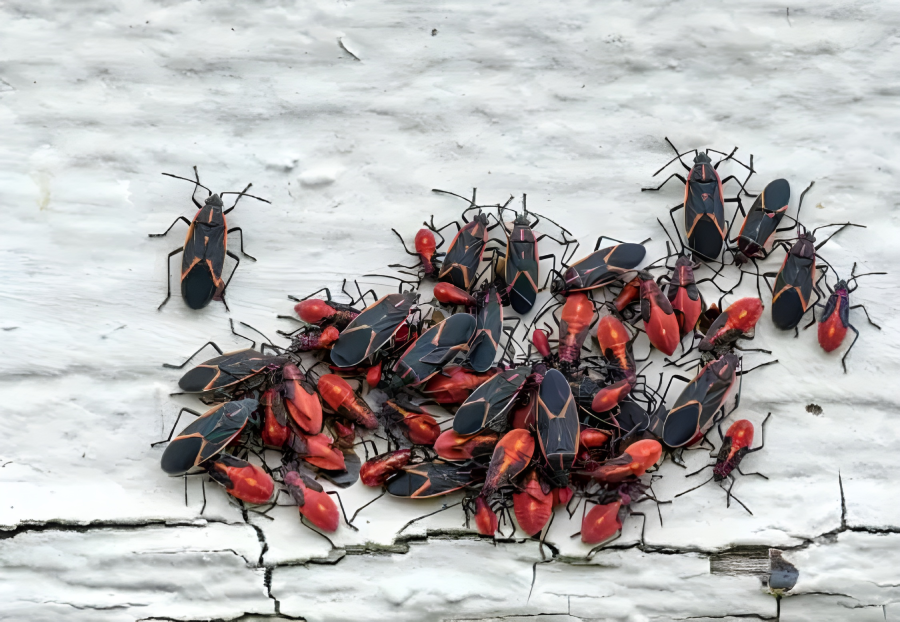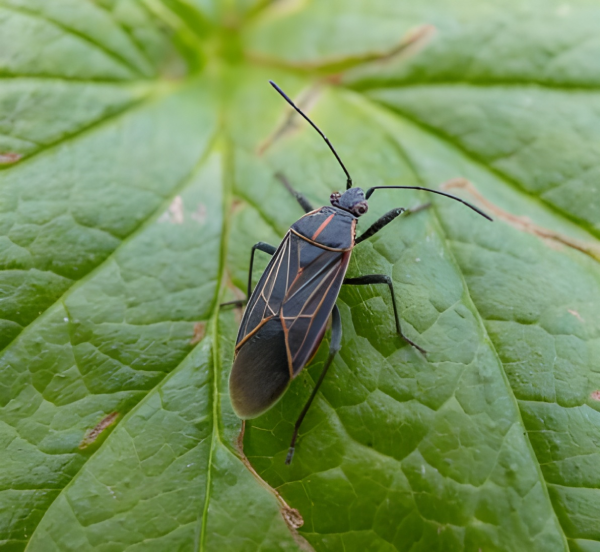Effective treatments with guaranteed relief
Box Elder Bugs
Box Elder Bugs are a common household pest that can quickly become a nuisance if not properly controlled. These insects are primarily found in outdoor environments but can make their way inside homes, particularly as colder weather sets in. While Box Elder Bugs do not cause significant harm to humans or property, their presence can be irritating. In this guide, we’ll explore everything you need to know about Box Elder Bugs, including how to identify them, how they get into your home, the potential impact they have, and what steps you can take to prevent and control their presence.




119 Google reviews
Book An Inspection
20+ Years Experience
100-Day Warranty
Licensed and Insured
What Are Box Elder Bugs?
Box Elder Bugs (Boisea trivittata) are small, black insects with distinctive red markings along the edges of their wings and bodies. Adult bugs are about half an inch in length, with elongated bodies and wings that create a V-shape when viewed from above. They are most commonly found on Boxelder trees, which serve as their primary food source, but they are also drawn to other types of maples and ash trees.
These bugs are not known to bite humans or pets, nor do they spread diseases. Despite their harmless nature, they can cause a number of issues for homeowners and businesses. Box Elder Bugs are primarily a nuisance pest, with their large populations and tendency to invade homes during colder months.

How Do Box Elder Bugs Get Into Your Home?
Box Elder Bugs are most active in late summer and early fall. As the weather starts to cool, these insects begin looking for places to hibernate, and unfortunately, homes provide the perfect sanctuary. Box Elder Bugs often enter homes through small gaps and cracks in windows, doors, and the foundation. They can also make their way through vents, chimneys, or any other opening that leads to the interior of a home.
One of the most common times for Box Elder Bugs to invade homes is during the fall months. As they begin migrating indoors, they seek warmth and shelter, clustering together in sunlit areas such as windowsills, walls, and attics. Once inside, they can be difficult to eliminate due to their ability to hide in cracks and other hard-to-reach spaces.
Identifying Box Elder Bugs
Recognizing a Box Elder Bug is easy once you know what to look for. These insects are typically:
- Color: Black with red markings along their thorax, wings, and abdomen.
- Size: About ½ inch (1.3 cm) in length.
- Shape: Elongated and oval-shaped with wings that form a V-shape when not in use.
- Movement: Box Elder Bugs are slow-moving and prefer to fly in short bursts.
Box Elder Bugs can often be spotted basking in sunny areas, such as window sills, walls, or under outdoor furniture. However, their presence may also go unnoticed until large numbers invade your home.
The Impact of Box Elder Bugs
While Box Elder Bugs do not bite, sting, or transmit diseases, their presence inside your home can still cause a number of issues. Here’s what you need to be aware of:
Staining:
When disturbed, Box Elder Bugs may release a yellowish fluid that can stain furniture, carpets, curtains, and other fabrics. This fluid, while not harmful, is difficult to remove and can cause permanent damage to delicate fabrics.
Odor:
Box Elder Bugs have a distinctive, unpleasant odor that they release when threatened or crushed. The smell resembles a bitter almond scent and can linger for days.
Appearance:
The sight of large clusters of Box Elder Bugs gathering on your windowsills, walls, and ceilings can be off-putting for many homeowners. Their presence can also create the impression that your home is infested with pests, even if they are harmless.
Allergy Concerns:
In rare cases, people with asthma or severe allergies may experience a mild reaction to the presence of Box Elder Bugs due to the odor they release when disturbed.
Despite these minor inconveniences, Box Elder Bugs do not cause any serious structural damage to homes or furniture. However, their sheer numbers and persistence can create a stressful living environment for homeowners.

Prevention and Control of Box Elder Bugs
If you’re dealing with Box Elder Bugs, taking proactive steps to prevent them from entering your home in the first place is the most effective method of control. Here are several ways to reduce the risk of an infestation:
1. Seal Entry Points:
One of the first things you should do to prevent Box Elder Bugs from entering your home is to seal any potential entry points. Inspect your windows, doors, foundation, and walls for cracks or gaps and seal them with caulk or weatherstripping. Don’t forget about vents, chimneys, and other openings that may not be immediately obvious. If you find small gaps, consider installing or repairing screens on windows and doors to keep bugs out.
2. Remove Boxelder Trees:
If possible, remove any Boxelder trees from your property. These trees are the primary food source for Box Elder Bugs, so eliminating them will help reduce their attraction to your home. If removing trees is not an option, consider trimming branches and leaves to limit access to the trees.
3. Outdoor Cleaning and Maintenance:
Keep your property free from debris and leaf piles, as these can provide a hiding place for Box Elder Bugs. Also, ensure that outdoor garbage cans are sealed tightly to prevent attracting pests.
4. Vacuuming and Traps:
If Box Elder Bugs have already made their way inside your home, use a vacuum cleaner to remove them. Be sure to dispose of the vacuum bag immediately, as the bugs may crawl back out if left inside. You can also use sticky traps or natural insect repellents to catch and remove Box Elder Bugs.
5. Insecticides:
For more severe infestations, you may want to consider using an insecticide that targets Box Elder Bugs. However, be sure to choose a product that is safe for indoor use and follow the manufacturer’s instructions carefully. If you’re not comfortable using chemicals in your home, consider hiring a professional pest control company to handle the problem.
Dealing with an Active Box Elder Bugs Infestation
If Box Elder Bugs have already invaded your home, it’s important to act swiftly to minimize disruption and prevent repeat infestations. While prevention is ideal, ongoing issues often require more targeted solutions.
1. Try Targeted Insecticides
Insecticides labeled for Box Elder Bugs can be used to treat active infestations, particularly around windows, doorways, siding, and attic spaces where bugs tend to gather. Always read and follow label directions carefully. Use should be limited to affected areas to avoid unnecessary exposure. If you’re unsure about which product to choose, consult a pest control professional for safe and effective recommendations.
2. Consider Professional Pest Control
When Box Elder Bugs become a recurring problem or enter your living areas in large numbers, it’s time to bring in the pros. Professional pest control services can identify how and where the bugs are getting in, apply long-lasting treatments to keep them out, and help fortify your home’s defenses for the future. It’s the best way to ensure complete removal and long-term peace of mind.
Ready to Eliminate Box Elder Bugs for Good? Contact Canadian Pest Solutions Today!
If you’re experiencing a Box Elder Bug infestation, you don’t have to handle it alone. At Canadian Pest Solutions, we specialize in eco-friendly pest control solutions designed to tackle even the most stubborn pests. Our experienced technicians can assess your home, identify any potential problem areas, and provide targeted treatments to eliminate Box Elder Bugs and prevent future infestations. Trust Canadian Pest Solutions for a thorough, long-lasting approach to pest protection—your home deserves nothing less.
Reclaim Your Home from Box Elder Bugs Today
You shouldn’t have to deal with the constant nuisance of box elder bugs invading your home. At Canadian Pest Solutions, we deliver fast, effective treatments backed by proven expertise and a satisfaction guarantee you can count on. Don’t wait, Contact us now to schedule your free inspection. Be sure to ask about special offers available for new customers. Say goodbye to box elder bugs for good. Let our professionals restore comfort and confidence to your home. Learn more about us.Client testimonials
What our clients say























